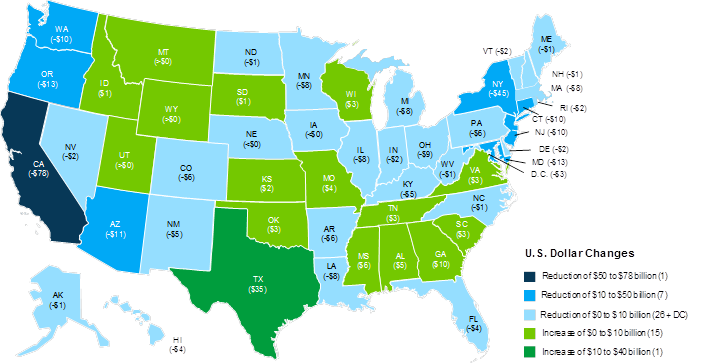A new report released Wednesday morning reveals just how much states could lose under the Senate GOP’s latest Obamacare repeal bill—in total, a decrease of $215 billion dollars in federal health care spending by 2026 and more than $4 trillion cut by 2036, according to the report by the health care consulting group Avalere.
The Senate could potentially vote next week on the Graham-Cassidy bill to repeal much of the Affordable Care Act and convert Medicaid into a dwindling block grant. The bill’s Republican backers acknowledge that there will be winners and losers under the plan, but they are planning to bring the bill to a vote without getting a complete analysis from the Congressional Budget Office of its cost and expected coverage losses, making independent assessments like Avalere’s among the few data points for analyzing the bill’s impact.
Under the bill’s formula, which largely redistributes money from blue states to red states, large, progressive states that expanded Medicaid under Obamacare would see the biggest cuts, with California and New York each losing tens of billions of dollars over the next decade under the plan. It’s important to note, however, that several states represented by Republicans in the Senate who are undecided on the bill, including Maine, Alaska, West Virginia, Ohio, and Arizona, would also see painful cuts.
The report’s first chart shows how much—in billions—states would gain or lose in federal dollars over the first decade after the bill goes into effect.
Cumulative Change in Federal Funding to States Under Graham-Cassidy Compared to Current Law, 2020-2026

The worst cuts, however, come in the second decade after the bill is enacted, when much lower growth rates in Medicaid per-capita spending kick in, and when the block grant funding expires altogether. Avalere modeled what would happen to federal health care spending after 2026 under the Graham-Cassidy plan, and found that the entire country would face a fiscal cliff, and that even the states that were “winners” in the first few years of the bill would see sharp reductions further down the road.
Cumulative Change in Federal Funding to States Under Graham-Cassidy Compared to Current Law, 2020-2036

The Graham-Cassidy bill, which could come to the Senate floor without a complete CBO score and after only one committee hearing, would end federal support for Obamacare’s Medicaid expansion and tax credits starting in 2020, kill the individual and employer mandates, and allow state governments to waive many of the core protections in the ACA—such as the rule banning insurers from charging people with pre-existing conditions higher rates.











Huh…appears that the largest gains are going to the locations that refused to expand Medicaid (deep South and Mormon west). If they didn’t want “those people” covered, what are they going to do with this new windfall?
I knew I’d seen Cassidy before…

Oh, and fuck you and all the other Republicans who will vote for this bill.
Just in time for Halloween! Ghouls on Parade! All the little kiddies can go as Republican’t Senators and scare the living shit out of everyone…
Damn, they’re really sticking it to Arizona. How much $$$ did Ducey get to voice his support for this turd? (I notice he didn’t sign the letter endorsing C-G with the rest of the hard-right governors…cold feet?)
Louisiana gets hit pretty hard too and the Louisiana state budget is already in shambles.